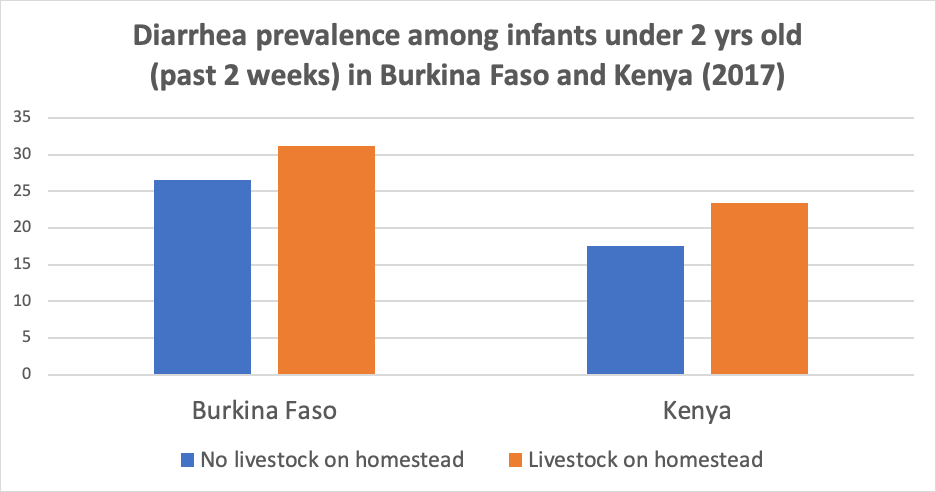By Devon Kristiansen
Last month, when IPUMS PMA released data from nine countries, including the most recent person level and service delivery point level surveys on family planning, we also released data on a new topic for Performance Monitoring for Action (PMA) – nutrition. PMA conducted two survey rounds each in Burkina Faso and Kenya (2017 and 2018) in both in people’s homes (households) and where they received care and medical services (service delivery points). Household surveys contained questions about the diet and nutritional status of children under 5 and women between 10 and 49 years, antenatal care and advice received by currently or recently pregnant women, and other household and demographic questions. Service delivery points were surveyed for medical equipment and services relating to malnutrition and anthropometric monitoring.
A key factor for nutrition status of young children in the low and middle-income country (LMIC) context is incidence of diarrhea. Diarrhea prevents the uptake of nutrients into the child’s body and causes dehydration. According to the World Health Organization1, diarrhea is the leading cause of malnutrition and second leading cause of death for children under 5 globally. A well-established association in the nutrition literature is the presence of livestock on the homestead and incidence of diarrhea in young children, due to fecal contamination of water and food sources2, 3.
The newly-released IPUMS PMA Nutrition data confirm past findings regarding the presence of livestock and diarrheal disease incidence. This blogpost is a brief, informal exploration of one type of research question these data can provide. In the Burkina Faso and Kenya 2017 Nutrition rounds, 26.9% of children under 2 years old living on a homestead with livestock present had experienced diarrhea in the past 2 weeks, compared to 20.2% of young children living on homesteads without livestock. The difference between these prevalence rates are statistically significant.

The richness of IPUMS PMA Nutrition data allow researchers to further study the nuances of this effect, and test other hypotheses related to child nutrition. For example, I looked to see if there was a significant correlation between the presence of livestock and diarrhea in young children after controlling for urban-rural status and examined the impact of possible mitigating factors.
It’s important to note the differences in how ‘urban’ and ‘rural’ are defined in different countries. For example, Burkina Faso’s definition of urban is a locality of more than 10,000 people with sufficient socio-economic and administrative infrastructures. In contrast, Kenya’s definition of urban is municipalities, town councils, and other urban centers with 2,000 or more inhabitants. The comparability tab on IPUMS PMA makes it easier to identify these differences and take them into consideration when comparing data across countries and surveys.
I found that higher wealth, secondary education or higher of the child’s mother, treatment of drinking water by boiling, and the presence of hand sanitation facilities in the household may have protective effects on children’s health, that is, these factors are associated with a lesser probability of diarrhea in young children.
Looking at the occurrence of diarrhea in young children and factors expected to mitigate it revealed unexpected results. Surprisingly, access to protected drinking water sources and treated water was positively associated with children experiencing diarrhea. Perhaps families do not take additional precautions when they perceive their drinking water source to be safe.
Also surprising was the finding that the mother’s educational level only seemed to have a protective impact when it was a post-secondary level. Primary and middle school educational levels among mothers was actually associated with greater diarrhea incidence when compared to mothers with less education.
The results I describe are the result of an informal look into IPUMS PMA’s new Nutrition data, and they hold so much potential for more research. There are more than 1000 new variables that have been added to IPUMS PMA from the Nutrition module data.
Like the family planning core surveys, household and service delivery point data can be linked together by the variable (the primary sampling unit). For more information on how to link person data and facility data, see our user note.
We hope you are able to leverage these data in your own research!
As always – use it for good!
1 https://www.who.int/news-room/fact-sheets/detail/diarrhoeal-disease
2Mosites, E. M., Rabinowitz, P. M., Thumbi, S. M., Montgomery, J. M., Palmer, G. H., May, S., … & Walson, J. L. (2015). The relationship between livestock ownership and child stunting in three countries in Eastern Africa using national survey data. PLoS One, 10(9).
3Kaur, M., Graham, J. P., & Eisenberg, J. N. (2017). Livestock ownership among rural households and child morbidity and mortality: an analysis of demographic health survey data from 30 sub-Saharan African countries (2005–2015). The American journal of tropical medicine and hygiene, 96(3), 741-748.




